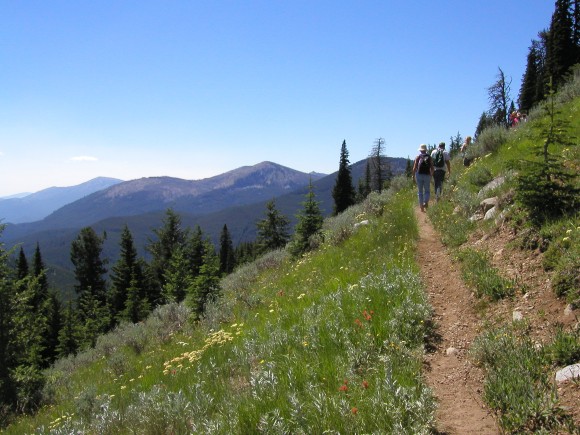
It’s a Wild Life – Can You Spare Some Passion?
by: Kettle Range Conservation Group: Tim Coleman Posted on: November 02, 2011
By Tim Coleman, Director of the Kettle Range Conservation Group and Cofounder of the Wild Washington Campaign, among other things.
Editor’s Note: Tim Coleman, a veteran in the effort to protect Washington’s unique wild lands, gives us a valuable perspective on the successes and failures of this movement.
For most people, wilderness is a noun meaning a wild place where wild things exist and that’s reason enough to like it. But what drives some of us to swim against a rising tide of environmental degradation to advocate for its protection?
To understand wildness is to understand it is vanishing and recognize that to do nothing is to be a participant, however unwilling, in its disappearance.
A law to protect wild places was envisioned by women and men as far back as the early 19th Century. A passionate lot, these women and men fought to preserve wild places from rapacious corporate greedheads and inept bureaucrats whose profit motive was to log, mine, drill, dam and otherwise develop every acre of the planet.
Teddy Roosevelt campaigned against corporate control of forestlands, establishing public ownership of national parks, grasslands and forests across the United States. Still, over time the conservation of resources, particularly federal forests, were again compromised by mismanagement of the U.S. Forest Service and other federal land managers.
In Washington State with passage of The Wilderness Act on September 3, 1964, Congress forever protected portions of Mount Adams, Glacier Peak and Goat Rocks. More importantly, the law gave citizens the ability to go straight to Congress to petition for preservation of other equally unique tracts of federal public lands, and thus bypass bureaucrats that all too often were beholding to corporate interests.
Every few years after the Act’s passage, Washington’s Congressional Delegation would legislate more wildernesses and each time it became a little harder to get from bill introduction to it being signed by the president. In 1968 the Pasayten Wilderness was established, 1976 Alpine Lakes Wilderness, and in 1978 the Wenaha-Tucannon Wilderness was the first to be designated east of the Cascade Mountains in the state. During the latter, a statewide wilderness movement began to take shape, first at the grassroots level and later as a coalition of groups calling itself the Washington Wilderness Coalition. This coalition helped preserve over 1 million acres under the 1984 Washington Wilderness Act.
As impressive as the accomplishments of the 1984 Act were, it would take another 25 years for Congress to designate another acre of wilderness in Washington. The Act had other consequences as well, the most notable of which was the release of millions of acres of wild roadless forests to logging and road development, particularly in eastern Washington’s drier ponderosa, larch and Douglas fir forests. Forest management plans developed in the mid and late 1980’s were prohibited from recommending additional wilderness and called for huge increases in logging that led to a sea of clearcuts from Mount Rainer to the Salmo-Priest Wilderness.
From enactment of forest plans up through the early 2000’s, the timber industry and Forest Service believed the issue of wilderness had reached finality and that all forests in the future would be managed to produce timber and other resources. But again, citizens rose up, forming Forest Watch groups across the region to protect wild and old growth forests.
Perhaps no other area of the state has fought so long and hard to protect its primeval forests than the citizens of northeast Washington who know and love the Colville, Kaniksu and Okanogan National Forest. Groups there worked tirelessly to add lands to the 1984 Act, only to get the 40,000 acre Salmo-Priest Wilderness designated. By Forest Service estimates, 50,000 acres of the Colville’s roadless areas proposed for wilderness fell to the chainsaw in just 8 years following passage of the ’84 Act and another 100,000 acres were planned but stopped by appeals and litigation.
In 1996, the group Eastern Washington Wilderness Activists was formed to organize public support for legislation to protect the eastside’s estimated 2 million acres of unprotected wilderness. After a short time this coalition joined with western Washington activists to form the Wild Washington Campaign that led to designation of the Wild Sky Wilderness in 2008. But of course, Wild Sky is not in eastern Washington.
Perhaps in the future, the unprotected wilderness of the Kettle Range, Selkirk, Blue and eastern Cascades will get their due? Grizzly bear, wolverine, mountain caribou, elk, lynx and other critters big, small and rooted inhabiting these Columbia Highlands are dependent on us to protect their last refuge and safe passage between the Cascade and Rocky Mountains that science says is critical to their survival. Unfortunately, history repeats itself. Who fights against future threats to unprotected wild public forests? And what if Congress kills environmental laws that provide current, though limited, safeguards? Can you help?
For more information go to www.kettlerange.org.
2 Responses to “It’s a Wild Life – Can You Spare Some Passion?”
Articles On Flora
Flora: Flora
- Apr 1 Big or Small: Who Will Grow Washington’s Cannabis Crop?
- Jul 19 A Case to Protect Public Land
- Apr 6 Oregon is a Desert State
- Dec 14 Forest Protection-The Olympic Peninsula
- Nov 30 Keeping Working Forests on the Landscape
- Nov 2 It’s a Wild Life – Can You Spare Some Passion?
- Sep 28 West Hylebos Wetlands: A Place Worth Preserving
- Aug 8 12,000 Rain Gardens
- Jul 11 Investing in Seed Banks
- Oct 21 Native Plant Spotlight: Oregon Grape
- Oct 21 Washington’s Roadless Forests


by: Steve Antheson: Monday 7th of November 2011
by: Christopher Youngon: Tuesday 15th of November 2011